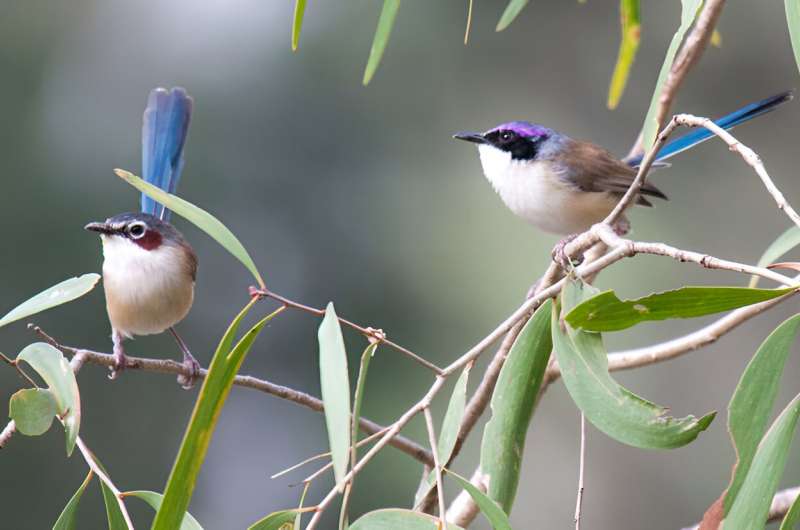November 20, 2023 report
This article has been reviewed according to Science X's editorial process and policies. Editors have highlighted the following attributes while ensuring the content's credibility:
fact-checked
peer-reviewed publication
trusted source
proofread
Why purple-crowned fairy-wrens engage in cooperative breeding
A team of biologists at Monash University, working with a colleague from Wageningen University, has found an explanation for why purple-crowned fairy wrens engage in cooperative breeding. In their paper published in the journal Royal Society Open Science, the group describes their study of the birds in the wild.
Prior research has shown that some creatures engage in cooperative breeding, in which some members of a group forgo reproduction and instead assist others in their group with rearing offspring, and purple-crowned fairy-wrens are one such species. Instead of mating with others, some of them serve as nannies, helping other breeding pairs rear their young. In this new study, the research team sought to understand this behavior.
The work by the team involved venturing to a remote site in the Kimberley region of Western Australia—the birds live there along creek lines—and studying them in their natural environment over several years. They captured multiple specimens and affixed tiny colored bands to their legs to keep track of individual birds.
By watching the birds over a long period of time, the researchers were able to track multiple generations, which allowed them to see that one of the benefits of cooperative breeding was a future opportunity to mate with one of the birds they were assisting, or even with one of those they were working with—quite often, a pair of reproducing birds would have several nannies assisting with rearing the young.
The researchers also found that cooperative breeding also served to build social bonds in small groups of birds, which in turn led to more security as it assisted the birds in spotting predators. They also found that in some cases, those assisting a breeding pair were related to one or the other of the breeders—an indirect way to pass on genes to offspring. Finally, they found that cooperative breeding often led to instances of nepotism, in which related assisting birds were treated more respectfully by others in the group than those that did not assist.
The research team therefore concludes that purple-crowned fairy wrens engage in cooperative breeding as a means of obtaining future benefits for themselves.
More information: Niki Teunissen et al, Best of both worlds? Helpers in a cooperative fairy-wren assist most to breeding pairs that comprise a potential mate and a relative, Royal Society Open Science (2023). DOI: 10.1098/rsos.231342
Journal information: Royal Society Open Science
© 2023 Science X Network

















